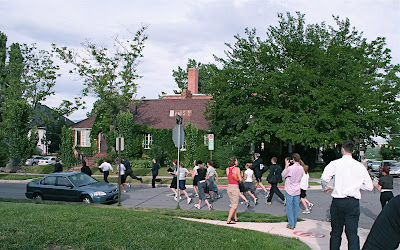In my dream I flew over the rolling hills of the llano. My soul wandered over the dark plain until it came to a cluster of adobe huts. I recognized the village of Las Pasturas and my heart grew happy. One mud hut had a lighted window and the vision of my dream swept me towards it to be a witness at the birth of a baby.
I could not make out the face of the mother who rested from the pains of birth, but I could see the old woman in black who tended the just-arrived, steaming baby. She nimbly tied a knot in the cord that had connected the baby to its mother's blood, then quickly she bent and with her teeth she bit off the loose end. She wrapped the squirming baby and laid it at the mother's side, then she returned to cleaning the bed. All linen was swept aside to be washed, but she carefully wrapped the useless cord and the afterbirth and laid the package at the feet of the Virgin on the small altar. I sensed that these things were yet to be delivered to someone.
Now the people who had waited patiently in the dark were allowed to come in and speak to the mother and deliver their gifts to the baby. I recognized my mother's brothers, my uncles from El Puerto de los Lunas. They entered ceremoniously. A patient hope stirred in their dark, brooding eyes.
This one will be a Luna, the old man said, he will be a farmer and keep our customs and traditions. Perhaps God will bless our family and make the baby a priest.
And to show their hope they rubbed the dark earth of the river valley on the baby's forehead, and they surrounded the bed with the fruits of their harvest so the small room smelled of fresh green chile and corn, ripe apples and peaches, pumpkins and green beans.
Then the silence was shattered with the thunder of hoofbeats; vaqueros surrounded the small house with shouts and gunshots, and when they entered the room they were laughing and singing and drinking.
Gabriel, they shouted, you have a fine son! He will make a fine vaquero! And they smashed the fruits and vegetables that surrounded the bed and replaced them with a saddle, horse blankets, bottles of whiskey, a new rope, bridles, chapas, and an old guitar. And they rubbed the stain of the earth from the baby's forehead because man was not made to be tied to the earth but free upon it.
These were the people of my father, the vaqueros of the llano. They were an exuberant, restless people, wandering across the ocean of the plain.
We must return to the valley, the old man who led the farmers spoke. We must take with us the blood that comes after the birth. We will bury it in our fields to renew their fertility and to assure that the baby will follow our ways. He nodded for the old woman to deliver the package at the altar.
No! the llaneros protested, it will stay here! We will burn it and let the winds of the llano scatter the ashes.
It is blasphemy to scatter a man's blood on unholy ground, the farmers chanted. The new son must fulfull his mother's dream. He must come to El Puerto and rule over the Lunas of the valley. The blood of the Lunas is strong in him.
He is a Márez, the vaqueros shouted. His forefathers were conquistadores, men as restless as the seas they sailed and as free as the land they conquered. He is his father's blood!
Curses and threats filled the air, pistols were drawn, and the opposing sides made ready for battle. But the clash was stopped by the old woman who delivered the baby.
Cease! she cried, and the men were quiet. I pulled this baby into the light of life, so I will bury the afterbirth and the cord that once linked him to eternity. Only I will know his destiny.
Rudolfo Anaya
Bless Me, Ultima (1972)



















































